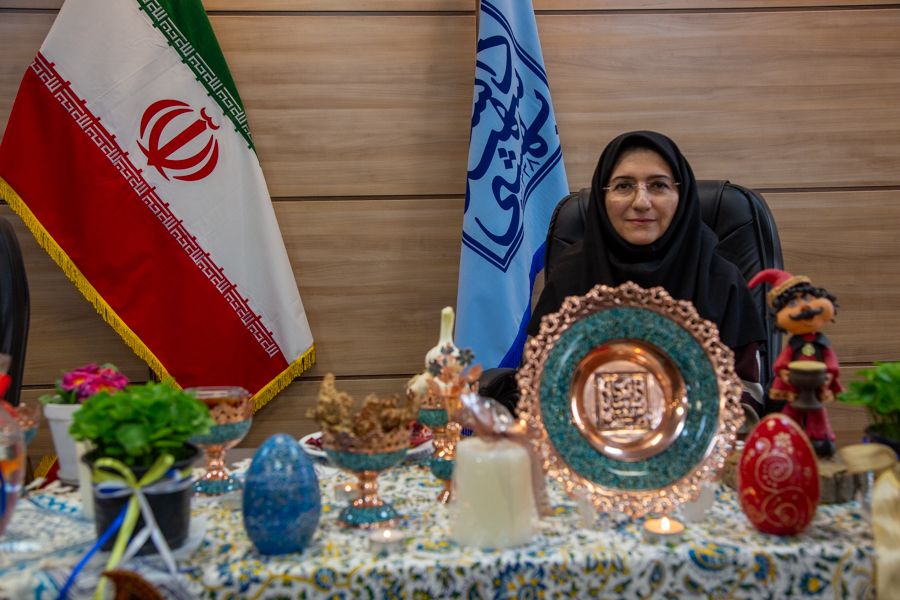
Dr. Arezou Rasouli is an assistant professor in the Department of History, Faculty of Letters and Human Sciences of Shahid Beheshti University. She, who has been the director of the history department since 2021, has authored and translated several works, including "Fire That Does Not Die", "From Zoroaster to Mani" and "The Parthian Empire and its Documents and Sources" [all in Persian]. In addition, Dr. Rasouli has authored articles such as "Myths of the Creation of Humankind: Comparative Mythology", “Anahita and fire worship rituals” and "Mélusine and Some Iranian Fairy Tales: A Comparative Study" [all in Persian]. Due to her expertise in the field of ancient Iran, we had an interview with her, part of which you will read below.
• The main topic of conversation with you is Chaharshanbe Suri and Nowruz celebrations. But before we get to this topic, please explain about other occasions of ancient Iran, which are of great importance.
Ancient Iranians used to celebrate different occasions. These celebrations usually had a religious flavor for them and were based on their beliefs. The word "jashn" [celebration] itself means praise and prayer. Among the most important celebrations of these people were rituals that were held every month. The days of the month had names in ancient Iran. When the name of the day turned the same as the name of the month, Iranians celebrated that day. In this way, there were 12 monthly festivals (Farvardinegan, Ordibeheshtegan, Khordadegan, etc.). In the meantime, Farvardinegan was an important festival in honoring the souls of the dead on Farvardin 19 (April 8). Although people visited graves on this day, it was still a celebration, not mourning. The next important monthly festival was Tiregan, which was held in Tir in honoring water, and water sprinkling was one of the rituals of this festival. Also, in myths, this day was the day of Arash Kamangir's archery and the expansion of the Iranian borders. Mehregan was another important festival. Mehregan was a very detailed celebration equaling Nowruz. In fact, Iranians had two great celebrations at the beginning of the two halves of the year, which were Nowruz and Mehregan. These two festivals were more related to agriculture. Another important festival is Esfandegan, which was considered women's day in ancient Iran. On this day, men gave gifts to their spouses. Apart from these, there were six completely religious festivals called "Gahanbar". Each of these were celebrated for five days, and commemorated the creation of the world. Ancient Iranians believed that God created the world step by step and in one year; first the sky, then the earth, then water, then plants, then animals and finally humans. In each of these Gahanbars, the memory of one of these creations was celebrated and as their name indicates, Gahan was read in these celebrations. The last Gahanbar, which is the most detailed, is the anniversary of the man’s creation, which is connected with Nowruz celebration. In fact, Nowruz, in addition to being a celebration related to agriculture and nature, is a celebration for the anniversary of the man’s creation. In other words, Nowruz is the celebration of the man’s birthday.
• Now let’s come back to Chaharshanbe Suri; please talk about the reason for its existence and honoring, its evolution over time and how it was performed in the past. At what point in history did this celebration begin or what does it date back to?
It is very difficult to speak about the beginning of this celebration, because there are no documents. But this tradition exists. Traditions are very strong in Iran and its survival to this day shows that it has a long history. This celebration was called "Suri" rather than Chaharshanbe Suri. Suri was a celebration that was held to commemorate the soul of the deceased. Iranians respected the souls of the dead since ancient times. This respect still remains. Iranians believed that in the new year, the souls of the deceased return to the earth; each of them comes to their house and brings blessings to the members of that house. Since they considered the souls to be pure and believed that they hate any kind of impurity, they cleaned their houses. In fact, they believed that if houses are polluted, the souls will not enter them and will not bring blessings to them. In this way, on New Year's Eve, they lighted fires on the roofs; the fire was a guide for the souls to find their way home. The word “Suri” is considered to mean both red (reminiscent of fire) and celebration. Anyway, the lighting of fires took place on New Year's Eve. But how this New Year's Eve celebration slowly moved to the Wednesday night of the previous year must definitely be sought in the post-Islam era. It is not clear when exactly this happened. However, the "History of Bukhara" by Narashkhi, written in the 4th century AH, spoke about Suri. That is, at that time this change had not yet happened. beyond that, the oldest information about this celebration is related to the Safavid period in the 11th century AH, which mentions the last Wednesday of the year. Since Iranians have usually adapted themselves to new beliefs and preserved their traditions, they may have associated Suri with Wednesday that was ominous among the Arabs and believed that lighting a fire on the night of the last Wednesday of the year will fix this. In this way, this celebration may have been moved to the last Wednesday night of the year. Of course, in many Iranian families, they still leave the house lights on at the last night of the year. This can be a remnant of the ancient Suri. Since Suri was one of the celebrations at the end the year, the rituals of this celebration were associated with a kind of fortune-telling; rituals such as ghashoghzani [similar to trick or treat] and Falgoush [overhearing]. For example, in the old days when ghashogzani was popular, it was believed that one should put food such as eggs, bread and sweets as blessings in the bowl of someone who comes for ghashogzani. In Falgoush, before it got dark, people went to the streets and made intentions. Then they would listen to see what anyone who passed said and considered that statement as the answer to their intention. This was so common that people were careful not to say bad things because someone might be overhearing. There have been different customs in different places. For example, in some places, the custom of breaking jars was widespread. According to this custom, the old jar of the house was thrown from the roof onto the street, with the intention of removing the evils of the previous year, so that the new year would come in with goodness.
• Please also talk about Nowruz; Nowruz has been almost the most important and biggest celebration and even though today many of the ceremonies you mentioned have been forgotten except for a few people, Nowruz has continued as one of the most important ceremonies of Iranians. How was Nowruz celebrated in the past? What can be said about its history?
Wherever people live, they have associated their rituals with their livelihood. Life in the Iranian plateau is strongly linked with agriculture. For this reason, Nowruz has a long history, with characteristics such as the change of seasons and the greening of plants. Many even consider Nowruz a pre-Aryan custom and say that this festival was celebrated before Aryans entered the Iranian plateau. Of course, Nowruz has changed a lot with different ethnic groups throughout the history. Aryans celebrated this festival, and associated it with their daily life, and even Zoroastrians have adapted it to their religious beliefs. For example, Zoroastrian Iranians believed that the day of resurrection takes place in Nowruz and all the dead will rise with their final bodies. As a result, they wore new clothes on Nowruz, which is a symbol of the same clothes they will wear on the Day of Resurrection.
Regarding your question about Nowruz rituals, the most common Nowruz custom is setting Haft Sin [seven Ss], which has changed a lot over time. Iranian farmers naturally wanted to know how their crops would grow in the new year. All rituals of Nowruz are associated with fortune-telling in some way. Ancient Iranians used to grow a small sample of the seven crops that they planned to plant in that year on the seven pillars, and from their growth, they understood how their crops would be in the new year. After Islam, these seven pillars turned to Haft Sini (Arabic for Chinese). In recent times, Haft Sini has been transformed into Haft Sin. Then these Ss have been changed during the course of time.
We have Ss that are good symbols for the new year. The first S is sabzeh (sprouted wheat grass). Sabzeh is a survivor of the same custom of planting grain or wheat. The second S is samanu (a sweet pudding made from wheat), which is again related to the custom of farming and growing wheat and preparing food from it. The third S is sonbol (hyacinth), which has a pleasant smell. The fourth S is sir (garlic), which was a health medicine in ancient Iran. The fifth S is senjed (the sweet dry fruit of the lotus tree), which is considered the trigger of love. The sixth S is sib (apple), which is a heavenly fruit and a symbol of birth. The seventh S is sepand (wild rue), which is called esfand today. Sepand repels the evil eye. Of course, apart from these Ss, there are other things on the Haft Sin, whose names do not begin with S, such as eggs (which symbolizes sperm and fertility), water (which symbolizes light), a mirror (which again symbolizes light), the Holy Book, grains such as wheat, rice and flour (depending on the taste of the family, as a symbol of blessing), all kinds of beans (again for blessing), sweets and noghl (comfits, for sweetness in the new year), lit candles (reminiscent of fire festivals and lit fires), fish (which is both a symbol of vitality and dynamism and a sign of Esfand month, pomegranate (which is a heavenly fruit and a symbol of Iranian fruit), bergamot or bitter orange (which is again a symbol of love) and Pussy willow (whose beautiful flowers turn green in spring).

